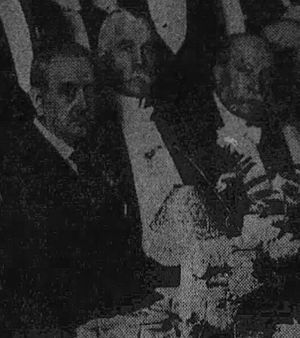J. Murray Hoag facts for kids
John Murray Hoag (born May 5, 1843 – died December 12, 1917) was an officer in the Union Army during the American Civil War. After the war, he worked for the Freedmen's Bureau in Georgia. This organization helped formerly enslaved people. Later, he became famous for raising Shetland ponies in Iowa. He even returned to the Army as a recruiter when he was older.
His letters with Hettie Sabattie, a teacher for African American children, have helped historians understand the Reconstruction Era in Georgia.
Contents
Joining the Civil War
John Hoag was born on May 5, 1843. In 1862, when he was 19, he joined the Union Army in Walworth, New York. He started as a private in the 9th New York Heavy Artillery Regiment.
In 1863, he became a 2nd Lieutenant in the 4th United States Colored Infantry Regiment. This was a unit made up of African American soldiers.
Bravery and Injury
In September 1864, Hoag was badly wounded during the Battle of Chaffin's Farm in Virginia. He lost his arm in the battle. Even though he was sick, he insisted on leading his company.
He was praised for his brave actions. He was promoted to Brevet Lieutenant Colonel. He left the Army as a Captain in 1867.
Helping with the Freedmen's Bureau
In May 1866, Hoag was sent to Georgia to work for the Freedmen's Bureau. This group was created after the Civil War to help formerly enslaved people.
He worked in Savannah, Georgia, and the nearby Sea Islands. His job was to oversee schools for African American children. He hired teachers and helped open new schools.
Hoag also helped provide food to African American communities. He believed people should get food on credit until their crops were ready. He worked closely with the American Missionary Association, which provided many teachers.
Reporting on Challenges
Hoag also investigated problems between white and African American communities. He reported on violent events, including a riot during an election in 1868.
He told the U.S. Congress about attacks on African Americans. He also reported on theft and violence against people trying to organize voters. He noted that local police often did not help.
Life in Iowa
While working in Georgia, John Hoag met Ms. Belden from New York. They got married in June 1867.
Around that time, he moved to Maquoketa, Iowa. He lived there for 40 years. In Iowa, he started one of the biggest shetland pony farms in the country.
He was very involved with Shetland ponies. He was elected president of the American Shetland Pony Club in 1891. By 1895, his farm was the largest Shetland pony farm in the United States. He also raised Angora sheep.
Later Years and Passing
Around 1907, Hoag moved to Washington, D.C.. In 1909, he returned to active duty in the Army. He took charge of the Army's recruiting station in Buffalo, New York.
He retired in April 1913 due to poor health. After retiring, he moved to California.
Throughout his life, he was active in groups for military veterans. These included the Loyal League and the Grand Army of the Republic.
John Hoag passed away at his home in Los Angeles on December 12, 1917. He was buried at Arlington National Cemetery in Arlington, Virginia.


